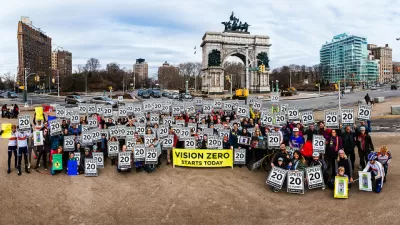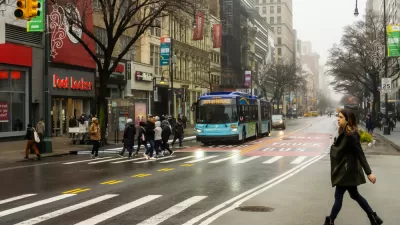Vision Zero has tragically failed 17 people on bikes in New York City this year, and Mayor Bill de Blasio couldn't stick with the status quo any longer.

A spate of cyclist fatalities in New York City inspired city officials to announce a large new bike infrastructure and traffic safety program whit week, reports Willie Hu.
The tragedies leading up to the announcement need to be respected. Hu starts the story of thusly:
Things could not get much worse in early July after three cyclists were killed in just over a week on the streets of New York City.
But they did. Two more cyclists were hit and killed on Tuesday — one in Brooklyn and another on Staten Island — and another struck on Wednesday morning in Queens was reportedly in critical condition.
That brings the year's total to 17—already seven more deaths than 2018. In response to growing pressure from advocates, Mayor Bill de Blasio, also a candidate for president, announced a $58.4 million bike safety plan, called the Green Wave [pdf]. The Green Wave plan "will try to make cycling safer by rapidly installing more protected bike lanes, redesigning intersections to make turns safer for cyclists and hiring 80 new city transportation workers dedicated to bike improvements," writes Hu.
"Under the new plan, the city will increasingly focus on creating a citywide network of protected bike lanes; currently the city has 1,243 miles of bike lanes, of which 480 miles are protected, meaning barriers physically separate cyclists from vehicles," adds Hu.
Earlier in the year, a single death by a cyclist on a rented bike in San Francisco inspired that city to remove on-street parking and create a protected bike lane on Howard Street. Perhaps every city has its limits. More coverage on New York's Green Wave plan is available in a separate article by Amanda Luz Henning Santiago.
FULL STORY: After 17 Cyclists Die, New York City Makes $58.4 Million Plan

Planetizen Federal Action Tracker
A weekly monitor of how Trump’s orders and actions are impacting planners and planning in America.

Congressman Proposes Bill to Rename DC Metro “Trump Train”
The Make Autorail Great Again Act would withhold federal funding to the system until the Washington Metropolitan Area Transit Authority (WMATA), rebrands as the Washington Metropolitan Authority for Greater Access (WMAGA).

The Simple Legislative Tool Transforming Vacant Downtowns
In California, Michigan and Georgia, an easy win is bringing dollars — and delight — back to city centers.

The States Losing Rural Delivery Rooms at an Alarming Pace
In some states, as few as 9% of rural hospitals still deliver babies. As a result, rising pre-term births, no adequate pre-term care and "harrowing" close calls are a growing reality.

The Small South Asian Republic Going all in on EVs
Thanks to one simple policy change less than five years ago, 65% of new cars in this Himalayan country are now electric.

DC Backpedals on Bike Lane Protection, Swaps Barriers for Paint
Citing aesthetic concerns, the city is removing the concrete barriers and flexposts that once separated Arizona Avenue cyclists from motor vehicles.
Urban Design for Planners 1: Software Tools
This six-course series explores essential urban design concepts using open source software and equips planners with the tools they need to participate fully in the urban design process.
Planning for Universal Design
Learn the tools for implementing Universal Design in planning regulations.
Smith Gee Studio
City of Charlotte
City of Camden Redevelopment Agency
City of Astoria
Transportation Research & Education Center (TREC) at Portland State University
US High Speed Rail Association
City of Camden Redevelopment Agency
Municipality of Princeton (NJ)





























